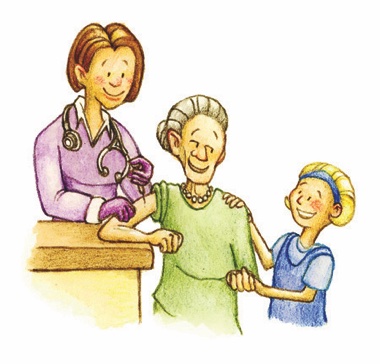As many Sun City residents rush this fall to get their flu vaccinations, it becomes important for us to consider another form of immunization: the Shingles Vaccine. What exactly is shingles? The disease is also called Herpes Zoster. Those of us who have had chickenpox (98% of Americans) are at risk for developing shingles. The virus that causes chickenpox never leaves your body and can emerge as a mild to severe painful rash. The U.S. Department of Health and Human Services Centers for Disease Control and Prevention does caution us, however, “Very rarely, a shingles infection can lead to pneumonia, hearing problems, blindness, brain inflammation, or death.”

Merck Drug Company, 2012, informs us: “You’re at greater risk for shingles as you get older. When you’re young, your immune system is usually strong enough to keep the virus in check. But your immune system weakens as you age, making it easier for shingles to break through your body’s defenses.” WebMD (10.13.15) adds stress and physical trauma as other risks.
“The shingles rash forms where the nerves from the spinal cord connect with the skin. This area is called a dermatone. Usually the rash will only appear along a dermatone located on one side of the body,” the drug company continues.
Though most often the rash will last from two to six weeks, shingles may produce severe, long-term nerve pain (one in five chance), which lasts for months or even years after the rash heals. In older patients, this postherpetic neuralgia, or PHN, risk increases with age.
One community resident, who was in her mid-60s when she got shingles, shouts loudly “It’s the worse thing that I had in my life! I’d be screaming (with pain) (PHN)!” Our senior took Neurontin for 6 months to 1 year to alleviate the pain. She thinks she developed the malady as a result of stressful days of treatment on a tooth root canal just before the outbreak of a rash on her neck.
“I still have some neuropathy in the neck area years later,” she says.
Linda Hallman, another resident, developed shingles two years ago while still in her early 50s.
“Because my rash (two patches on my thigh) was so light in color and in size, I didn’t see the doctor for 14 days after my pain was already too great. I spent three days in bed and the initial shingles lasted 6 weeks. The residual damage done by [PHN] was the worst. The nerve damage went into my sciatica nerve all the way down my leg and into my foot. At that time I couldn’t sit, stand, or walk. I needed an electric scooter to move around. Because I feared my husband would get chicken pox from me, Ralph had his hands full. He used separate sheets for each side of our bed, and washed them daily in hot water. My doctor prescribed for me an extremely heavy dosage of Gabaprentinto which Paxil was added. The doubling of this latter antipsychotic med has proven to be the best pain reliever of the two (the former med was dropped). Thankfully, my rash did not blister or spread its contagious fluid to Ralph. I have learned to live with the occasional prickly feeling of neuropathy still in my foot,” said Hallman.
There are even more disturbing shingles facts:
Each year in our country there are more than 1 million shingles cases.
One in three people will develop shingles during their lifetime; one in every four people will develop a complication of this dreaded disease.
WebMD (10.13.15) adds, “People who have never had chickenpox and have not been vaccinated (as well as an unborn child)…can develop chickenpox if exposed to the virus.” If suspecting the shingles illness and having seen a physician at once for antiviral meds, the medical website recommends that the patient have limited contact with others for at least three days.
Judy, a 50-year-old resident of Fox Lake, who recently saw her doctor within a 24-hour period after discovering a small bright red rash in her back waist area, said the itching is now gone after an 11-day period due to the use of a recommended calamine lotion spray. Judy is taking Acyclovir (Zovirax), an antiviral medication, to control the spread of the virus. She takes Tylenol and Ibuprofen for pain relief.
The Shingles Vaccine (Varicella Virus Vaccine) was first licensed in 2006, and in clinical trials, has reduced the risk of people developing the disease by 50 percent. Also, the vaccine can reduce the pain level of those still getting the infection after receiving the shot. The possibility of developing shingles a second time is rare, and extremely rare to develop it a third time. Having a history of chicken pox, a single dose of the vaccine is recommended for adults 60 years of age and older; for individuals who are in their 50s and 60s, a doctor’s prescription is required. Please check with your doctor if you have severe allergies or a weakened immune system or are pregnant or ill with a high temperature before getting the inoculation. If after getting the shot, you experience any difficulty with your health, other than redness or itching at the site of the injection, please get immediate medical help.




